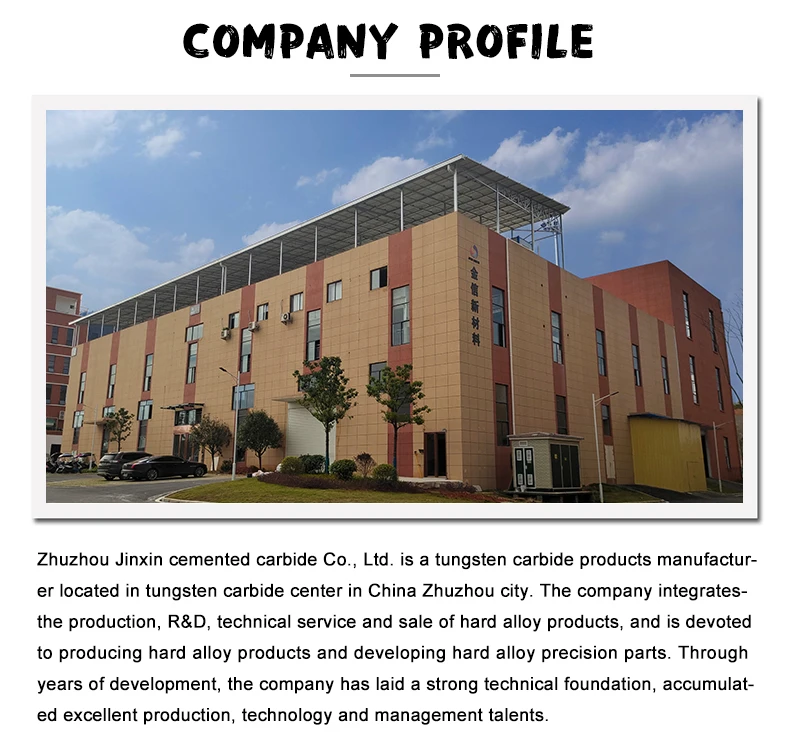| Availability: | |
|---|---|


JINXIN
High Hardness Tungsten Carbide Bar For Wood Cutting
Tungsten Carbide Bars are one of the ideal tool materials for cutting wood. Hard alloy is a multiphase composite material composed of one or more carbides of refractory metals (such as tungsten carbide, titanium carbide, etc.) as the hard phase, bonded by metal binders (such as cobalt, nickel, etc.). It has many advantages such as high hardness, good wear resistance, and good red hardness.
2. Advantages of cutting wood: High hardness and wear resistance: During the cutting process, wood may contain various impurities such as sand particles. The high hardness of hard alloy strips (usually with a Rockwell hardness HRA of 89-92.5) can easily handle these impurities and will not wear out as easily as ordinary cutting tools. For example, compared to high-speed steel cutting tools, hard alloy long cutting tools can maintain their sharpness even after cutting a certain amount of wood continuously, with much less wear and tear. Good red hardness: When cutting wood, heat is generated due to friction and other factors. Hard alloy strips can maintain their hardness and cutting performance at higher temperatures. For example, in the case of high-speed cutting or cutting thick wood causing an increase in tool temperature, the hard alloy strip will not soften due to the temperature increase, thus ensuring the accuracy and efficiency of cutting.
3. Types
Classified by alloy composition: There are hard alloy strips with tungsten carbide as the main hard phase. Tungsten carbide has high hardness and can effectively resist the wear of wood. This alloy strip is suitable for cutting wood with high hardness, such as oak, walnut, etc.
There are also hard alloy strips with added titanium carbide and other components. Titanium carbide can further improve the hardness and wear resistance of alloys, and to some extent enhance their toughness. This type of strip performs well in cutting both softwood and hardwood.

| Type (L×W ) | Thickness (H) | Length tolerance (L) | Width tolerance (W) | Height tolerance(H) |
| 100×100× | 2.5~60 | L×±1.5% | W×±2.5% | H×±2.5% |
| 120×120× | 2.5~60 | L×±1.5% | W×±2.5% | H×±2.5% |
| 150×150× | 2.5~60 | L×±1.5% | W×±2.5% | H×±2.5% |
| 200×200× | 2.5~60 | L×±1.5% | W×±2.5% | H×±2.5% |
| 300×200× | 2.5~60 | L×±1.5% | W×±2.5% | H×±2.5% |
YG6 has higher abrasion resistance, but lower than YG3, better than YG3X in shock and vibration resistance. Suitable for cast iron, non-ferrous metals and alloys, non-metallic materials, semi-finishing and finishing of medium cutting speed.
YG8 has high strength, better impact resistance and vibration resistance than YG6, but lower wear resistance and allowable cutting speed. Suitable for cast iron, non-ferrous metals and alloys, non-metallic materials, low-speed roughing.


High Hardness Tungsten Carbide Bar For Wood Cutting
Tungsten Carbide Bars are one of the ideal tool materials for cutting wood. Hard alloy is a multiphase composite material composed of one or more carbides of refractory metals (such as tungsten carbide, titanium carbide, etc.) as the hard phase, bonded by metal binders (such as cobalt, nickel, etc.). It has many advantages such as high hardness, good wear resistance, and good red hardness.
2. Advantages of cutting wood: High hardness and wear resistance: During the cutting process, wood may contain various impurities such as sand particles. The high hardness of hard alloy strips (usually with a Rockwell hardness HRA of 89-92.5) can easily handle these impurities and will not wear out as easily as ordinary cutting tools. For example, compared to high-speed steel cutting tools, hard alloy long cutting tools can maintain their sharpness even after cutting a certain amount of wood continuously, with much less wear and tear. Good red hardness: When cutting wood, heat is generated due to friction and other factors. Hard alloy strips can maintain their hardness and cutting performance at higher temperatures. For example, in the case of high-speed cutting or cutting thick wood causing an increase in tool temperature, the hard alloy strip will not soften due to the temperature increase, thus ensuring the accuracy and efficiency of cutting.
3. Types
Classified by alloy composition: There are hard alloy strips with tungsten carbide as the main hard phase. Tungsten carbide has high hardness and can effectively resist the wear of wood. This alloy strip is suitable for cutting wood with high hardness, such as oak, walnut, etc.
There are also hard alloy strips with added titanium carbide and other components. Titanium carbide can further improve the hardness and wear resistance of alloys, and to some extent enhance their toughness. This type of strip performs well in cutting both softwood and hardwood.

| Type (L×W ) | Thickness (H) | Length tolerance (L) | Width tolerance (W) | Height tolerance(H) |
| 100×100× | 2.5~60 | L×±1.5% | W×±2.5% | H×±2.5% |
| 120×120× | 2.5~60 | L×±1.5% | W×±2.5% | H×±2.5% |
| 150×150× | 2.5~60 | L×±1.5% | W×±2.5% | H×±2.5% |
| 200×200× | 2.5~60 | L×±1.5% | W×±2.5% | H×±2.5% |
| 300×200× | 2.5~60 | L×±1.5% | W×±2.5% | H×±2.5% |
YG6 has higher abrasion resistance, but lower than YG3, better than YG3X in shock and vibration resistance. Suitable for cast iron, non-ferrous metals and alloys, non-metallic materials, semi-finishing and finishing of medium cutting speed.
YG8 has high strength, better impact resistance and vibration resistance than YG6, but lower wear resistance and allowable cutting speed. Suitable for cast iron, non-ferrous metals and alloys, non-metallic materials, low-speed roughing.


